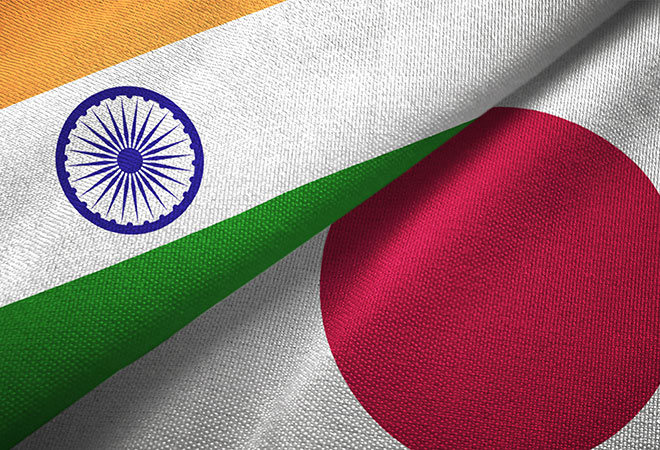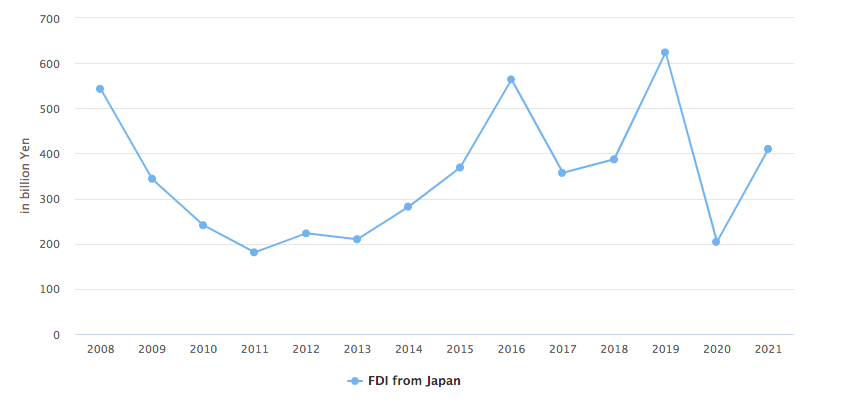
Tactical Power Shift
India & Japan for open Indo-Pacific, game changing bilateral ties define Prime Minister Fumio Kishida’s visit to New Delhi
Prachi Mishra
Japanese Prime Minister Fumio Kishida’s two-day visit to India is part of on-going bilateral engagement between the countries agreed in 2006. Since then, Indian and Japanese leaders have consistently worked on strengthening ties and auguring a stronger and open Indo-Pacific.

Prime Minister Kishida’s visit signals growing influence of QUAD. It is also significant as India and Japan presently hold the G20 and the G7 presidencies respectively. Kishida’s visit comes in the wake of San Shinzo Abe’s tragic death. Prime Minister Abe is regarded as a great friend of India seeking to reconnect two classical civilizations.
Kishida’s statements have pointed to a turning point with continuity in bilateral strategic relations. Highlight of his visit was to unveil a plan on Open and Free Indo-Pacific for which he committed US $ 75 billion.
Japan and India have a long and shared history of bilateral relations, strategic cooperation, and a resolve to build a peaceful Indo-Pacific.
Historical connect
India and Japan share centuries-old relationship. Their ties can be traced back to the sixth century when Buddhism was introduced in Japan and adopted as a way of life in Japanese society.
In 752 AD, Bharatiya Buddhist monk Bodhisena consecrated the Todaiji Temple at Nara. The towering Buddha statue at Tara has weathered many storms and stood the test of times. All through the last few centuries, India and Japan have never been adversarial towards each other and their relations have been free of disputes.
In the recent past, Swami Vivekananda, Netaji Subhash Chandra Bose, Rabindranath Tagore, and JRD Tata have been Indian cultural ambassadors to Japan[1].
In contemporary times, India and Japan signed a peace treaty after the Second World War which not only established India’s diplomatic relations in Japan but also uplifted morale of Japanese people who were recovering from the aftermath of the war. India also extended its iron resources to the war-torn Japan and helped immensely in its reconstruction. The first yen-loan was extended by Japan to India after Premier Nobusuke Kishi’s official visit to India in 1957.
The two nations also find a lot of commonality in upholding democratic principles and rule of law. There have been umpteen trade and commerce deals between India and Japan. Set up in 1903, the Japan-Indian Association is the oldest global informal organisation in Japan.
Economic and commercial cooperation
Trade and commerce ties between India and Japan have steadily strengthened over last few decades. Both nations have a mutually beneficial relationship; Japan has tapped into India’s emerging and expanding market while India has relied on Japan for technology transfers and financial assistance. India-Japan Comprehensive Economic Partnership Agreement signed in 2011 is the most holistic agreement that not only facilitates movement of goods and services but also human resource, shared development of intellectual property, and custom processes.
Japan has been the largest financial donor for India. Over the years, Japan has supported India in infrastructure and technological development in sectors like railways and roadways, power, and environment. The most recent and the most relevant projects are Ahmedabad – Mumbai High Speed Rail, Western Dedicated Freight Corridor, Delhi-Mumbai Industrial Corridor, and the Chennai-Bengaluru Industrial Corridor. The Delhi Metro Rail Corporation was also facilitated by Japanese assistance. Table 1 lists items of trade between India and Japan.
Table 1. Import-export goods in Indo-Japan trade ties.
| Imports from Japan to India | Exports from India to Japan |
| Machinery and instruments | Petroleum products |
| Transport equipment | Chemicals and compounds |
| Iron and steel goods | Fish and by-products of fisheries |
| Electronic equipment and goods | Metal ores and scrap |
| Organic chemicals | Clothing, textiles, accessories |
| Tools | Iron and steel products |
During financial year ending March 31, 2022, India was the 18th largest trading partner for Japan. Concomitantly, Japan was the 13th largest trading partner for India. Also, Japan’s foreign direct investment has soared in the last few years, with India becoming the 5th largest investing country for 2021-22. India has seen a sharp rise in the number of Japanese firms totalling to 1455 that operate in India. Fig. 1 and Fig. 2 show the value of trade carried out between the two countries since 2008.

Fig. 1.Trade values of Indo-Japan trade. Source: Ministry of Trade and Commerce, Government of India. Ministry of Economy, Trade, Industry, Government of Japan. CIHS Analytics

Fig. 2. Foreign direct investment from Japan to India in the last few years. Source: Ministry of Trade and Commerce, Government of India. Ministry of Economy, Trade, Industry, Government of Japan. CIHS Analytics.
India has been the biggest recipient of the Japanese Official Development Assistance (ODA) loans in the last few years. India receives these loans from Japan under the latter’s “Act East” policy and “Partnership for Quality Infrastructure”. Table 2 summarises Japan’s ODA towards India.
Table 2. Japan’s ODA towards India[2]
| Loans | 312.25 billion Yen | 2021-22 |
| Grants | 5.12 billion Yen | 2020-21 |
| Technical Cooperation | 8.5 billion Yen | 2021-22 |
The two countries have strengthened their relationship by focusing on developing strong supply chains through the India-Japan Industrial Competitiveness Partnership. Both India and Japan have also been striving for environmental protection and reduction of greenhouse gases. Their Clean Energy Partnership which was formulated in March 2022 focuses on achieving carbon neutrality and working towards energy security. Along with the Japan-India Energy Ministerial Dialogue, it also aims for a strategic cooperation plan in the fields of hydrogen, ammonia, and LNG.
Science and technology cooperation
Both India and Japan have benefitted from their science and technology cooperation over last several decades. While Japanese firms have revolutionised the Indian technology market, Indian software engineers, scientists, mathematicians, and technologists have contributed immensely to scientific research and development in Japan.
India and Japan signed bilateral Science and Technology Cooperation Agreement in 1985 to foster an era of scientific advancement in the Indo-Pacific. Subsequently, the India-Japan Science Council (IJSC) was set up in 1993 facilitated several advancements. Till date, it has[3]
- Held 19 annual meetings
- Delivered over 250 projects
- Facilitated over 1600 scholarly exchanges
- Organised over 65 joint seminars
- Held over 10 Asian Academic seminars; and
- Conducted over 10 Raman-Mizushima lectures
Over 550 students have attended exchange programs through a joint cooperation programme between Department of Science and Technology (India) and the Japan Science and Technology Agency (JSTA). The two Asian economies collaborate in nearly every area of scientific research and development.
Defence and security cooperation
India and Japan have a long association apposite defence and security cooperation. From technology transfers to naval exercises, the two have pledged for a safe Indo-Pacific. In 2008, India and Japan signed the Joint Declaration on Security Cooperation to pave way for defence and security cooperation. Several other frameworks and bilateral arrangements like Foreign and Defence Ministerial Meetings (2+2 meetings), Annual Defence Ministerial Dialogue, and Coast Guard to Coast Guard Dialogue have facilitated the joint vision of a stronger Indo-Pacific. Recently, in September 2022, the second 2+2 meeting was held in Tokyo. In 2020, the two countries also signed the Acquisition and Cross-Servicing Agreement to smoothen the passage of supplies and services of the two armed forces. The Agreement came into effect in July 2021.
Cultural cooperation
India and Japan share strong cultural ties which have evolved over decades of cooperation and friendship. Since the 1950s, Japanese students have been offered academic scholarships to study in India. Over the years, Indian leaders have initiated cultural exchanges and events to promote Indian culture in Japan. The Vivekananda Cultural Centre was established in Tokyo in 2009. The Indian Council of Cultural Relations established chairs for Indic studies at Ryukoku University, Kyoto and Reitaku University in Chiba. As a strong mark of cultural connect, the Yoga Organisation of Japan and the Quality Council of India set up a Scheme for Voluntary Certification of Yoga. Similarly, the last few years have also seen many friendly exchanges to promote Indian dances, culinary delights, languages, and music.
Through their diaspora, both India and Japan have strengthened their bilateral ties. As of October 2022, there were more than 8,140 Japanese citizens in India and over 40,750 Indian citizens in Japan[4].
Observations
In his latest visit to India, Japanese Prime Minister Kishida stressed on the importance of greater cooperation and resilience to balance growing Chinese geopolitical influence in the Indo-Pacific. He shared his vision for a free and open Indo-Pacific and highlighted the need to effectively deal with issues of food security and soaring energy prices. His visit also speaks volumes on making regional groupings like the QUAD, G20, and the G7 more relevant. Japanese Prime Minister Kishida’s visit immediately after US Secretary of State Anthony J Blinken and Australian Prime Minister Anthony Norman Albanese descending on New Delhi provides a big clue to tactical shift in major power play. India has emerged as an indispensible player in the changing global matrix.
[1] Refer 2
[2] Ministry of Foreign Affairs, Government of Japan.
[3] India – Japan Relations, Ministry of External Affairs, Government of India.
[4] Refer 2

